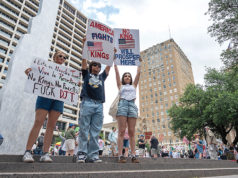The state’s positivity rate, which is the percent of virus tests coming back positive, has increased to levels not seen since January. This indicates the highly transmissible delta variant of COVID-19 is spreading rampantly and mostly among the unvaccinated. Hospitals across the state are seeing dramatic jumps in COVID-19 patients, straining an already overburdened health care system.
The U.S. Centers for Disease Control and Prevention (CDC) is now recommending vaccinated people start masking up again in indoor public spaces in “areas with substantial and high transmission,” which includes most of Texas, and some of the state’s largest counties except Tarrant are also asking everyone — vaccinated and unvaccinated — to wear masks again. However, Gov. Greg Abbott has said public schools and government entities cannot require masks, which has upset parents and teachers as students — most of whom are unvaccinated — prepare to return to in-person learning.
Meanwhile, almost 44% of all Texans are fully vaccinated, but the number of vaccines administered has been declining every month since April. New preliminary data released by the Department of State Health Services shows that 99.5% of COVID-related deaths in Texas were unvaccinated people between Feb. 8 and July 14. The percentage of fully vaccinated residents went from 3% to 42% in that time span.
Everyone age 12 and older is eligible for the vaccine in Texas, regardless of occupation or health status. Only the Pfizer vaccine is available to people ages 12 to 17.
How many Texans have been vaccinated?
As of Aug. 1, 15 million people have received at least one dose, which is 51.6% of Texas’ population, and 12.7 million people, or 43.9%, are fully vaccinated. A total of 26.6 million doses have been administered. The Pfizer and Moderna vaccines require two doses, and the Johnson & Johnson vaccine requires one dose.
Health experts estimate 75% to 90% of Texans would need to be vaccinated to reach herd immunity. This is about 22 million people or nearly 100% of adults in the state. The state is still far from reaching that threshold, even when considering people who have some immunity from a previous case of COVID-19. The CDC recommends people previously infected get vaccinated because scientists aren’t sure how long immunity lasts for them.
The state’s vaccination effort has faced geographic, demographic, and data challenges, many of which are unique to Texas, including a higher-than-average number of people who are too young to be vaccinated and a sluggish data collection system that can take days to publicly report doses administered.
A third of Texas’ population lives in more rural areas, where the fully vaccinated rate has consistently lagged the statewide rate. State health officials initially rolled out vaccine hubs to help administer shots, but in May, the state shifted the responsibility to a growing number of doctors, pharmacies, public health offices, and other smaller providers who have closer relationships with the community.
Who is getting vaccinated?
The first groups eligible for vaccines were long-term care facility residents and staff, Texans age 65 and older, front-line health care workers, and people age 16 and older with qualifying health conditions. The virus has mostly killed people 60 years and older, prompting urgency in efforts to vaccinate older Texans.
The distribution of the vaccine is unequal, according to a Texas Tribune analysis. Among people who have received at least one shot, the percent of white recipients is more in line with their proportion of the state’s population while Hispanic and Black residents are being vaccinated at lower rates. In Texas’ largest counties — Harris, Dallas, Tarrant, Bexar, and Travis — neighborhoods with the highest proportions of Black and Hispanic populations are some of the least vaccinated areas.
Advocates say that language barriers and lack of access to health care providers and transportation have contributed to these disparities. Lower-income individuals also face challenges trying to book a vaccine appointment through a process that favors people who have easy access to the internet and transportation.
The Hispanic and Black populations in Texas are younger compared with the state’s white residents, which also adds to the disparities. Around 20% of the Hispanic population is under 12, and none of the vaccines are approved for children below 12. A majority of Texans age 80 and older are white.
How many people have died?
The first death linked to the coronavirus in Texas occurred March 15, 2020[,] in Matagorda County. As of Aug. 2, 52,110 people who tested positive for the virus have died in Texas. DSHS counts deaths based on death certificates that list COVID-19 as the cause of death, which excludes deaths of people with COVID-19 who died of another cause.
Some regions with the highest mortality rates are predominantly Hispanic. The virus has been more deadly in Hidalgo and Cameron counties in the Rio Grande Valley, where death rates rival more populous parts of the state like Dallas and San Antonio. In El Paso County, thousands of residents have died of COVID-19 since the pandemic began, placing the region far ahead of other major urban counties in deaths per 1,000 residents.
How many coronavirus tests are coming back positive?
The positivity rate measures how prevalent the virus is in Texas. A rate over 10% puts states in the “red zone,” according to federal guidance. During Texas’ two largest outbreaks, the rate exceeded 20%, meaning one in five tests were positive.
How many tests have been administered?
As of Aug. 1, Texas has administered 34 million tests for the coronavirus since March 2020. We do not know the number of Texans who have been tested because some people are tested more than once. The state’s tally does not include pending tests.
A version of this story originally appeared in the Texas Tribune.












